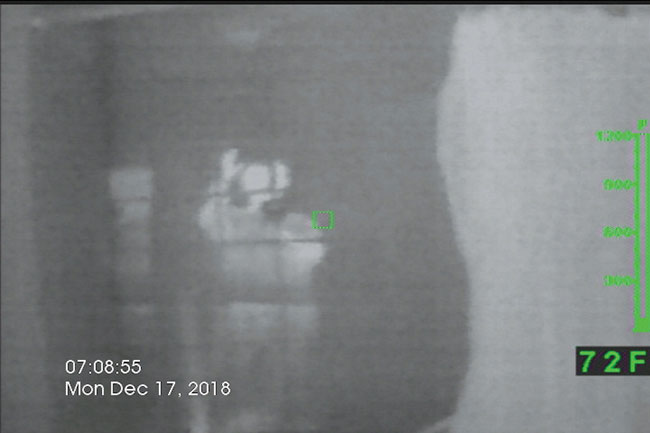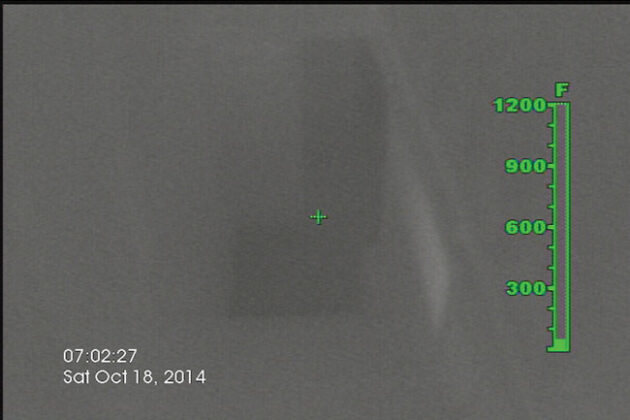
Features
Thermal imaging: A training refresher
Here’s a round-up of the most easily forgotten thermal imager tips
September 19, 2022
By Manfred Kihn
 Reflection caught with a TI off a ceramic tile wall of an open shower curtain
images: Bullard
Reflection caught with a TI off a ceramic tile wall of an open shower curtain
images: Bullard The COVID-19 pandemic made for some challenging times for frontline workers that went about their daily tasks to the brink of exhaustion. While fire departments may not have suffered the extreme upheaval that healthcare workers had, many changed their routine at the firehouse during this time. I’m particularly thinking about their training programs. With social distancing rules in place, some fire departments continued with their drills, while some were hesitant to bring extra crews together in person. Others halted all training until further notice.
If your training schedule had been disrupted, let’s use this time as a refresher. I’ve pulled together the most easily forgotten thermal imaging tips. Let’s dive in!
- Keeping your vision. Wipe both the display and front germanium lens on your thermal imager (TI) often during fire attack/suppression. Dirt, carbon and fogging inhibit the ability for heat to pass through the lens to the detector, lowering the level of heat detail on the monitor. This can limit your information and may impact proper image interpretation.
- Know what’s normal. We all understand that a thermal imager tells us what is hot and what is not. But if we don’t benchmark what “normal” looks like, how do we know what is not? For instance, a structure in the heat of summer will look completely different in the cold of winter. Both appear as “normal” heat images based on the emissivity of the building construction materials, temperature, sun exposure, etc. Knowing what to look for that is not normal takes practice.
- Look behind you. When entering an unknown structure using a thermal imager, it’s important to also turn and look back even though you are using a TI. As you move through a structure, passing through multiple doors, the landscape looks different at your back. Occasionally, take a look at your potential exit course so you can paint the image in your mind.
- Beware of reflections. Modern day kitchens are a potential room full of reflective surfaces. Stainless appliances, granite counters, high gloss wood cabinets and marble/ceramic floors can all give false impressions. Bathrooms are also one of the most common rooms that offer reflective and possibly misleading images. If you think that you are looking at yourself through the lens of a TI then that is your reflection. Confirm by giving a little wave!
- Share what you see. Paint verbal images for the rest of your crew as you use thermal imaging. Remember, you may have the benefit of a strong visual through your TI but often your crew following behind will be blind in the current conditions. Giving good verbal descriptions of room layouts and contents will improve the ability for the entire crew to move more effectively through unknown structures.

What is called a black hole – not visible are the stairs leading to the basement
- Don’t forget the floor. Sounding the floor is still required, even when you’re using thermal imaging. Did you know that liquids on a floor will often appear the same as a hole in the floor to a thermal imager? The imager will identify a difference in the floor area. Increase your safety by combing your visual cues with basic fire fighting tactics to better identify floor stability.
- Outdoor search and rescue in the woods. Are you prepared and do you understand the limits as well as the advantages of grid/distance detection that a thermal imager offers? Having a cooler background while looking for a victim that is generating more heat will be seen for a greater distance. The opposite occurs when you have a warmer background. A victim not generating as much heat will only be detected at a shorter distance. Learn what you can and can’t see and understand the relationship of distance and body heat.
- Hazard checks. At MVCs with rollover vehicles, be sure to use a thermal imager to check for any potential hazards such as downed power lines and fuel spills. Touching undetected hot wires could be a fatal mistake.
- Victim check. Use a thermal imager to look at all seats, front and back, including child carrying seats for heat signatures during MVC rollovers or downed motorcycles to ensure for accountability against ejected victims.
- Keep batteries in top condition. Battery maintenance on your thermal imager is vital. You can maintain your batteries by draining and recharging on a schedule. Double-check with your crew, if you aren’t actively implementing a battery maintenance schedule, here’s my favorite tip: every time “C” shift works on Friday have them drain the battery, replace with a spare and recharge the other.
- Grab the TI on every call. There may be some calls where a thermal imager doesn’t seem like a great fit. However, it can provide a benefit in many circumstances. For instance, even when working in confined spaces (i.e., finding victims in tunnels and culvert systems) use your thermal imager to detect humans at 300 feet or more, whereas you’ll only have about 50 feet of visibility with a flashlight.
Thermal imagers are only as effective as the end-user’s interpretation or misinterpretation of the image. To an inexperienced eye, the best technology can be useless or possibly fatal. Training during these unprecedented times is equally important as the message is clear: Practice, practice, practice.
Until next time stay safe and train often.
Manfred Kihn is a 19-year veteran of the fire service, having served as an ambulance officer, emergency services specialist, firefighter, captain, and fire chief. He has been a member of Bullard’s Emergency Responder team since 2005 and is the company’s fire training specialist for thermal imaging technology. He is certified through the Law Enforcement Thermographers’ Association (LETA) as a thermal imaging instructor and is a recipient of the Ontario Medal for Firefighters Bravery. If you have questions about thermal imaging, you can e-mail him at manfred_kihn@bullard.com.
Print this page
Advertisement
- Regional District of Nanaimo wants policy for recognition of volunteer firefighters
- $20M in federal funding going toward wildfire prevention for 29 N.W.T. communities